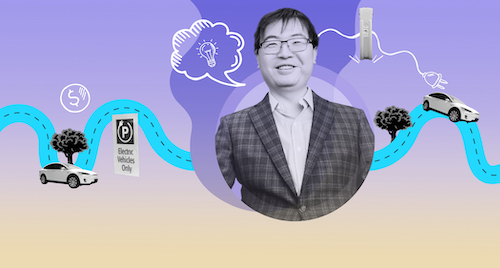
Taking the carbon out of UM-Dearborn’s commuting culture is one of the most important challenges the university will face as it moves toward a net-zero future. It will also be one of the trickiest to solve. What we succinctly refer to as our “commuter campus” is actually a complicated collective phenomenon made up of thousands of individual actions about how we get from place to place. Moreover, these actions are themselves rooted in complex phenomena, like transportation and housing affordability, government policies, and a consumer-choice landscape that car companies have largely defined for us.
You might wonder, then, where do we even start? That’s a question Associate Professor Wencong Su has been wrestling with recently while serving on the U-M President’s Commission on Carbon Neutrality Mobility Electrification Analysis Team. And he’s laid out some interesting ideas that could help UM-Dearborn begin to chart a path forward.
First and foremost, since the biggest component of our commuting is miles traveled by students, staff and faculty in personal vehicles, it’s assumed that getting folks to switch to electric vehicles (EVs) will be a big part of the solution. Moreover, it’s generally agreed that investing in larger-scale charging infrastructure on campus is one of the main ways the university can encourage that switch. But how you design, manage and optimize that system is where things get complicated, Su says.
Typically, a researcher like Su would start by taking a look at the data from the existing on-campus charging infrastructure. But UM-Dearborn currently has just a handful of charging stations — and none of them are set up to collect data. “It’s kind of a chicken and egg problem,” Su explains. “You can’t really understand customer behavior until you have more chargers. But it’s difficult to define a strategy for adding more chargers without a deeper understanding of customer behavior.” For that reason, Su suggests it might be a good first step to invest in a modest fleet of, say, 100 EV charging stations, then monitor customer usage data, and then make a data-informed plan about scaling it up.
Su says the more interesting question, though, is what kind of pricing scheme should be attached to on-campus EV chargers. Currently, there’s no fee, and many people think keeping them free is the best way to incentivize buy-in of EVs. Su, however, isn’t sold that free is ultimately better. For one, he says, there is no such thing as free, and a “free” pricing scheme means the university will ultimately be responsible for the electric bill. Whether that’s financially sustainable once EV use grows significantly is a big unknown.
Perhaps even more importantly, though, making the chargers completely free means you can’t harness the power of pricing to influence customer behavior (which is one of Su’s big areas of research). “We know that people are very sensitive to prices, so if we have a dynamic pricing system that incentivizes people to change their time or level of use, then we have a mechanism for optimizing the system,” Su says. “If it’s free all the time, then nobody cares when they’re charging, so it’s harder to influence customer behavior.” Su says this will become a really big deal when EV charging starts to put a greater strain on the electric grid. Having ways, such as pricing, to encourage people to not charge their cars all at the same time could be key to maintaining a stable electric grid, particularly one based on renewables.
Another cool idea that Su thinks could help the business case for expanding charging infrastructure: Making campus chargers available to the public during weekends and evenings, when university parking lots are at less than capacity. This could help bring in additional revenue to maintain the charging infrastructure — and incentivize members of neighboring communities to switch to EVs.
Finally, we should say that Su’s work with the commission didn’t exclusively focus on EV charging. He was also tasked with looking at ways to decarbonize the campus shuttle fleet, which is currently powered by diesel. With many fewer miles traveled, it’s a much smaller challenge in terms of carbon footprint, but it has its complexities. For starters, the university currently contracts for its shuttle service, which means it can’t directly implement any technology changes on its own. However, in the future, if we did decide to run our own fleet of electric shuttles, Su says he’s ready to help us figure out which technology is the best fit — and of course, how to pay for it.
###
Want to learn more about commuting and Su’s work on the Mobility Electrification Analysis Team? You can read some of their key recommendations in the latest report from the U-M President’s Commission on Carbon Neutrality. You can also weigh in with your feedback on the commission’s draft recommendations through Jan. 22.





